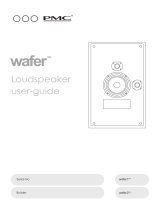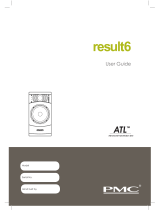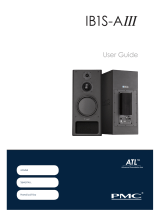Page is loading ...

series
Serial No
Builder
Model
Your guide to the ultimate
audio experience
The reference of professionals
‘We make the loudspeakers that make the whole world sing’

Product Support
For product support, accessories or servicing advice, please contact a PMC authorised dealer
see www.pmc-speakers.com.
Warranty Certificate
Please take a few moments to complete the warranty card at the back of this booklet or
register at www.pmc-speakers.com. This records the purchase of your loudspeakers and
provides you, the customer an opportunity to make suggestions and provide feedback
directly to PMC.
WEEE EU Directive
This symbol on the product or in/on its packaging indicates that this product must
not be disposed of with other household waste. It is the responsibility of the owner
to dispose of waste equipment via a designated collection point for the recycling
of waste electrical and electronic equipment. The recycling of your waste equipment is an
attempt to conserve natural resources and ensures that it is recycled in
a manner that protects human health and the environment. For more information about
where you dispose of your waste equipment for recycling, please contact your local
waste/recycling authority or the dealer from whom you purchased the product.
Company Details
PMC LIMITED
43-45 CRAWLEY GREEN ROAD LUTON LU2 OAA UK
T 0870 4441044 F 0870 4441045
email sales@promonitor.co.uk web www.pmc-speakers.com
PMC USA LLC
17971 SKY PARK CIRCLE DRIVE SUITE G IRVINE CALIF 92614 USA
T 949 861 3350 F 949 861 3352
email [email protected] web www.pmc-speakers.com
© 2008 PMC. All rights reserved.
Version v2 - #5380
This document should not be construed as a commitment on the part of PMC. The information it contains is subject to change without notice.
PMC assumes no responsibility for errors that may appear within this document.
CE Conformity PMC passive loudspeakers conform to CE Directive LVD 73/23/EEC and EMC 89/336/EEC.
WEEE European directive - PMC Limited is a member of a National Compliance scheme and have gained the associated certification
of compliance and the following registration number from the Environment Agency WEEE/GJ0101WU

Our sole aim while designing loudspeakers was to recreate the
true essence of an artist's intention, combining an ultimate level
in sonic resolution with solid engineering principles.
We believe that the same loudspeaker can be used throughout
the entire audio chain - from composer to studio or film stage,
and then finally the consumer. Our unswerving passion for
getting it right has made this goal possible.
Thank you for choosing PMC products. It is now time for you to
read the user guide, press the play button, and realise just how
much you've been missing.
Peter Thomas
Owner & Chief Designer
A message from Peter Thomas -
arguably the world’s smartest
loudspeaker designer ...
and a truly obsessive audiophile.

Congratulations you have joined the elite
Stevie Wonder Prince Google
Coldplay Kraftwerk Peter Gabriel
Robbie Williams Brian May
Eleanor McEvoy Francis Rossi -
Status Quo Brian Ferry
Peter Andre Bryston Tori Amos
Underworld Crystal Method
Tony Bennett John Rutter
Rough Trade BBC Radio BBC TV
Capital Radio Piccadilly
Radio RTL Emil Berliner/Deutsche
Grammophon NFL (National
Football League) teldex Studios
Hospital HDTV Broadcast Studios
Digidesign Siemens EMI Royal
Shakespeare Company DECCA
The Moving Picture Company
Paul Merton ORF The University of
Music - Düsseldorf The Royal
School of Music JVC DENON UK
The Royal Astronomical Society
Warner Music Capitol records
Chesky records N.Y. University
With PMC you can to hear exactly what the artist intended,
not a poor interpretation.
Robbie Williams Advantage - USA BBC London - UK
Mastermix - USA
Francis Rossi Pierce Rooms – UK
Orf - Austria
Brian May Metropolis - UK
Telegenic – UK
Teldex - Berlin
Swoon Factory - Austria Optimum Mastering - UK
Studio Delphine - France
Emil Berliner Studios - Berlin BBC Sounds One OB - UK
Teldex - Berlin The Hospital Studio HDTV Centre - UK
Nautilus Masterung - Italy Metropolis - UK

Loudspeaker User Guide
Contents
General Usage Guidelines
Introduction
PMC’s ATLTM Approach
Our Attention to Detail
Unpacking
Plinth Installation
Connections
Running or Breaking in
Magnetic Shielding
Stands & Brackets
Positioning
Stereo set-up
Surround sound specific set up
Ideal 5.1 surround set up
Ideal 7.1 surround sound set up
Fine tuning for perfect bass
Music produced with PMC
Suggested Associated Loudspeakers
Service
Specifications
Warranty On-line
Warranty Certificate - Our Copy
Help us improve - Your Comments
Warranty Certificate - Your Copy
Albums produced using PMC
Inspection Certificate
36
34
39
38
37
35

General Usage Guidelines
Read these instructions and keep them in a safe place for future reference.
Heed all electrical safety warnings, including any on the loudspeakers themselves.
Do not use the loudspeakers near water.
Only clean the unit with a dry, lint-free, cloth. Do not use solvents, abrasives,
waxes or liquids.
Spikes for use with the floorstanding models and the Tube Stands™are sharp and
should be treated with great care during installation and use.
Do not install near any heat sources such as radiators, ovens or other equipment that
produce excessive heat.
Unplug this product from both source and power during electrical storms or when
unused for extended periods of time.
Packing material can pose danger to the young and vulnerable.
Ensure these items are kept or disposed of safely.
High volume audio signals, however short their duration, have the potential to cause
hearing damage. Use care when setting the system volume level to ensure playback
sound pressure levels remain within safe comfortable limits.
Do not attempt to service the equipment. There are no user serviceable parts inside.
Please refer all servicing to PMC authorised personnel.
Servicing is required when the apparatus is damaged, exposed to moisture, or exhibits
a distinct or sudden change of operation or audio performance.
PMC has made efforts to provide accurate installation information and good quality
fixings. PMC LTD/PMC USA LLC will not be held responsible or liable for injuries or
property damage - direct, indirect or consequential - arising out of use or inability
to use this product safely and properly.
Series User Guide

Series User Guide
Introduction
The is the embodiment of our innovative approach to professional audio
monitoring, brought to the home.
PMC products are to be found in every demanding application, from broadcast to
major film scoring to CD and DVD mastering. The accumulated technical knowledge
and high level of engineering excellence developed over many years at the pinnacle
of professional studio monitoring has been incorporated into the development and
production of the - leading professionals such as BBC Radio and Television,
Dolby Laboratories, DTS, Dreamworks USA, JVC Studios Japan, Lucasfilm and Coldplay,
use PMC loudspeakers. There are no differences between the production of
professional and domestic product bar the cabinet finish.
The models, including their corresponding horizontal centre channel versions
have been engineered with identical tonal balance and dispersion characteristics.
This makes them ideal to ‘mix and match’ to create the ultimate high resolution Home
Theatre system in any domestic setting.
The sub/.1 effects channel within a system is ideally handled by the
professional proven TLE1 active subwoofer which excels in production of both sheer
level of bass energy and musical subtlety when required.
See page 24 for all the associated products or www.pmc-speakers.com
‘Kein kommentar’
Kraftwerk
‘Truly Another World’
Brian May - Queen
‘They’re * * *king brilliant’
Francis Rossi - Status Quo

PMC’s ATLTM Approach
The world’s leading professionals rely on the accuracy of PMC’s ATL™designs everyday to
create much of the music and sound you hear everday.
PMC’s ATL™(Advanced Transmission Line) enclosures have taken loudspeaker design to the
highest level. A PMC transmission line design utilises sophisticated cabinet construction,
proprietary drive units and patented absorption materials and techniques. The benefits are
enormous compared to the relatively simple sealed and ported models currently available
elsewhere.
The main driver is placed at one end of a long tunnel (the transmission line), which is heavily
damped with absorbent acoustic material. This material is specified to absorb the upper
bass and higher frequencies that radiate from the rear of the main driver. The lowest
frequencies, which remain in phase, then emerge from the large vent at the end of the line,
which essentially acts as a second driver. One advantage to this approach is that the air
pressure loading the main driver is maintained, thus controlling the driver over a wide
frequency range, which in turn significantly reduces distortion.
A spin-off from the lack of distortion is that the upper bass and midrange is not masked by
harmonic distortion residing in the very low
frequencies. The result is PMC characteristic
transparent midrange and fast, attacking
bass notes, all with outstanding clarity.
A further advantage of the transmission line
approach is a cabinet that produces
a higher SPL and lower bass extension
than a ported or sealed design of
a similar size. Moreover, as the
loading on the main driver is
maintained at all volumes, the
frequency response also remains
consistent regardless of listening level.
Neither casual late night listening nor
prolonged monitoring sessions have
to be conducted at high volumes to
achieve maximum bass response,
a characteristic that is especially
suited to the home user.
Series User Guide
Hand finished,
balanced veneer.
(inside & out)
Hand made,
matched, high order,
precision crossovers
Inert, ultra rigid
cabinet braced
by internal baffles
Ultra low
distortion drivers,
tried and tested in
the pro world
Precision
computer cut
panels and
joints
100%
Medite™
core
Custom profiled
line damping,
increasing air
density up to 30%
DB1i - The smallest ATLTM in the range

Our Attention to Detail
All PMC loudspeakers are hand-built in the U.K. using individual components that are
matched to our reference model; this includes the structural integrity of every cabinet
and the testing and recording of each component. This guarantees it will be within our
strict tolerances and ensures your purchase sounds identical to the original design.
Each completed loudspeaker then undergoes a set of objective and subjective
measurements - frequency response sweeps ensure that the design meets our
exacting performance criteria, and then listening tests are conducted against the
reference model using a wide variety of material, from a benchmark BBC speech test
to classical music, pop and rock.
Series User Guide

Unpacking
Please retain your packaging for future use as all PMC cartons are durable,
reusable and can be employed to safely transport your loudspeakers should
they be relocated.
Much of the packing is constructed from recyclable materials, so if you are
to dispose of it please do so in an environmentally friendly manner.
Packing materials can pose danger to animals, the young
and vulnerable. Ensure these items are kept or disposed of safely.
Series User Guide

Series User Guide
Plinth installation guide for the
floorstanding models
(Note the EB1i plinth is fitted prior to shipping)
Plinths are used to enhance the performance and stability of the floorstanding
models in the range. They attach to the base of each speaker using M8
bolts and accommodate the supplied spikes for use on carpeted surfaces. Plinths
should be installed as follows:
Carefully invert the loudspeaker so that its base is uppermost. Take care not
to damage the top of the loudspeaker when it is upside-down, the use of
a soft cloth or square of carpet is suggested.
Position the plinth on the bottom of the loudspeaker so that its large curved
edge is to the front (same face as the drive units) and the metal inserts are
facing up towards you. Ensure that the corresponding inserts in the base of
the cabinet are aligned with the rebated holes in the plinth.
Locate the large M8 bolts and tighten them gently by hand, then using the
supplied Allen key. Ensure that the bolts are not over-tightened.
Fully thread each spike with one of the supplied lock nuts. The spikes can
then be attached to the plinth; they should point upwards whilst the cabinet
is inverted. Caution: the spikes are sharp and should be treated with
great care and may damage hard flooring if in direct contact.
Re-invert the loudspeaker so that the spikes and plinth are at the bottom.
Once in position, level the loudspeaker by adjusting each spike in turn.
While this might seem a time-consuming exercise, it is important both in
terms of system performance and the stability of the cabinet.
The final step is to tighten each spike’s lock nut; this will ensure that the spike
and loudspeaker are as rigid as possible.

Series User Guide
Connections
Caution
To avoid potential damage, please ensure that your power amplifier(s) or receiver is
turned off before making or breaking any loudspeaker connections.
Cable & connectors
When selecting cables for use with your PMC loudspeakers, ensure that their
construction is of a high enough standard to withstand the rigors of everyday use and
that they are suitably terminated. While bare wire can be accommodated by the
binding posts, we recommend the use of either spade lugs or 4mm ‘banana’
plugs in order to maintain an electrical connection of the highest integrity and avoid the
possibility of short circuits. Please consult your dealer for more information regarding
cable lengths and termination options.
Polarity + & -
It is of vital importance to observe the polarity markings and maintain positive-to-positive
and negative-to-negative connections from amplifier or receiver to the loudspeaker.
The terminals are colour-coded to aid in their identification, positive terminals are red,
negative terminals are black.
Plugging them in

Series User Guide
+
+
-
-
HF
LF
+-
+
+
-
-
+
+
-
-
HF
LF
Diagram of back panel
standard/single wiring
Diagram of back panel
bi-amp connection
Diagram of back panel
bi-wiring
Connection of 2 way speakers
(Speakers with two drive units - a tweeter and a woofer)
Standard connection - A single cable with two conductors
Connect using any of the two pairs of RED+/BLACK- terminals. Ensuring the gold linking bars
are secure and the binding posts are finger tight.
Advanced connection
The i series speakers with two drive units (a woofer and a tweeter) can be bi-wired.
By loosening all four rear binding posts, the angled bridging plates can be removed thus
enabling separate signals to be fed to the low (Woofer) and high frequency (Tweeter)
drivers. Ensure the binding posts are re-tightened after the bridging bars are removed.
Both bi-wiring and bi-amping require the use of two lengths of cable per speaker.
Bi-amping requires two separate amplifiers; one for each driver. Please consult your dealer
regarding the benefits and the correct procedure.
Terminal identification
Top pair of terminals - HF / High Frequency / Tweeter
Bottom pair of terminals – LF / Bass Frequency / Woofer
tweeter
woofer

Diagram of back panel tri-amp wiring
Diagram of back panel bi-amp wiring
Diagram of back panel
standard/single
wiring
Diagram of back
panel bi-wiring
Diagram of back
panel tri-wiring
Series User Guide
Connection of 3 way speakers
(Speakers with three drive units - a tweeter, midrange dome & woofer)
Standard connection - A single cable with two conductors
Connect using any of the three pairs of RED+/BLACK- terminals. Ensuring the gold linking
bars are secure and the binding posts are finger tight.
Advanced connection
The i series speakers with three drive units (tweeter, mid range dome & woofer) can
be bi-wired, bi-amplified, tri-wired or tri-amplified.
By loosening all six rear binding posts, the angled bridging plates can be removing thus
enabling separate signals to be fed to the low (Woofer), mid (75mm Dome) and high
frequency (Tweeter) drivers. Ensure the binding posts are re-tightened after the bridging
bars are removed.
Both bi-wiring and bi-amping require the use of two lengths of cable per speaker,
tri-wiring and tri-amping require three lengths per speaker. Bi-amping also requires two
separate amplifiers; tri-amping requires three, one for each driver.
Please consult your dealer regarding the benefits and the correct procedure.
Terminal identification
Top pair of terminals - HF / High Frequency / Tweeter
Middle pair of terminals - MF / Mid Frequency / 75mm Dome
Bottom pair of terminals - LF / Bass Frequency / Woofer
(The CB6i terminal plate is at 90 º to those illustrated here. The LF terminals on the far right)
tweeter
mid dome
woofer

Series User Guide
15+ hours
to run-in
Running or breaking in
When loudspeakers are new they will take time to reach their full potential.
It is often debated whether any solid-state equipment, such as CD players or
transistor-based power amplifiers change with use, but the characteristics of
mechanical devices such as loudspeakers do alter and improve their performance
significantly after a short ‘running in’ period.
The science is simple; as the soft material surrounding the dome or woofer cone is
flexed it will eventually reach a point where it has optimum compliancy allowing the
drive unit to move more freely. This translates to greater accuracy and speed of
attack in the bass region and the mid and high frequency produces a far more vivid
audio picture. This short ‘running in’ period takes approximately 15 hours of
normal use.

Series User Guide
Magnetic Shielding
Loudspeakers contain magnets. The magnetic shielding option is ideal for those
with CRT (tube style) televisions or when other sensitive items are close by.
Shielded models are denoted by the “M” suffix and can be positioned
adjacent to magnetically sensitive devices without negative effect. We still
recommend that valuable, magnetically sensitive items such as tapes are not left in
close proximity for extended periods of time.
If your loudspeakers are not magnetically shielded, please ensure that they are
positioned at least 1metre away from items that could be damaged by stray
magnetic fields. Conventional glass tube (CRT) televisions and computer monitors
together with media such as floppy discs, cassettes and videotapes are particularly
susceptible.
If you have any queries contact your dealer for further advice regarding positioning
or upgrading to a shielded version.
N
S

Series User Guide
Stands and Brackets
Consumer frame stands – for use with the large models in the i series
The ‘designer’ frame stand takes it’s influences from great architects works as Mies Van
De Rohe & Marcel Breuer. Their work, as with the consumer frame stand, display clean
simple lines which seem effortless to create, but in truth hide a large commitment to
R&D. This form is easy on the eye, but also a stunning technical performer. Its delicately
simple shape belies its integral strength which allows the loudspeaker to operate
perfectly from a stable a rigid platform. The frame is ‘tuned’ and damped with
a precise quantity of filling, making certain there is no colouration from unwanted
resonance.
Adjustable M8 spikes or glides allow for leveling and give the structure an ideal
coupling with the floor surface.
Tube 104™
(104cm/41'')
The PMC Tube 104™high-mass stand have been specifically designed
and pre-tuned to guarantee maximum performance from the compact
models in the .
Tailor made mounting brackets are available from your PMC
dealer, they affix to the DB1i with four 6mm bolts on the rear
panel. The DB1i wall brackets can be angled precisely and
rigidly in both the horizontal and vertical planes again
ensuring maximum performance.
For more information about PMC stands and brackets please contact
your dealer or refer to our web site, www.pmc-speakers.com

Series User Guide
Positioning
With their unique ATL™Advanced Transmission Line design, wide dispersion, ultra low
distortion and smooth bass roll-off, PMC loudspeakers are more forgiving of difficult
room conditions and placement constraints than conventional designs - you will be
able to achieve a superb sound throughout the room with little effort. We do
encourage you to spend some time experimenting in your own room in order to
achieve the very best results. Remembering that small changes in location can often
influence system performance.
Room shape, size, construction and interior decoration vary immensely and therefore
influence sound in different ways. The following guidelines are suggestions for the
starting point to locate your new speakers. Fine-tuning of their positioning can start
from here.

Series User Guide
•Place the speaker so the front face is slightly forward of any large object that
protrudes into the room - this could be a fireplace, bookcase or television
for example.
Tip See stereo set up diagram
•Ensure that stereo pairs of loudspeakers are equidistant from the listening position.
Tip Some arrival time differences can be accommodated within modern home
theatre receivers and processors (see the instruction manuals provided with such
equipment for more on time alignment).
•It is best to position the front left/right pair (and centre channel loudspeaker if you
have a surround system) at the same height, usually at ear-level when seated at
the listening position.
Tip If any of the speakers are mounted above or below, then angle the speaker
towards the listening position.
•The distance between your left/right speakers and the listening position should
ideally create an equilateral triangle. As a general rule, the width of the audio
picture will be narrow if the speakers are too close together. If they are too far
apart the picture will be wide but there will be less central definition
Tip Use a well recorded vocal track to judge the ideal spot.
•To further enhance the audio picture or soundstage the speakers can be
angled/toed-in’. Start with the speakers angled so they will cross approximately
50cm (2ft) behind the listening position. (See stereo set-up diagram) Varying this
angle will also subtly affect the vividness of the audio picture, so again experiment.
Tip A simple well recorded band with vivid vocals will help to achieve the best position

Stereo Set Up Diagram
Series User Guide
/












